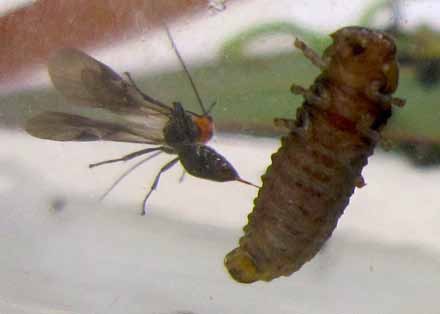PESTS AND DISEASES OF FORESTRY IN NEW ZEALAND
Biological control of Paropsis charybdis
Scion is the leading provider of forest-related knowledge in New Zealand
Formerly known as the Forest Research Institute, Scion has been a leader in research relating to forest health for over 50 years. The Rotorua-based Crown Research Institute continues to provide science that will protect all forests from damage caused by insect pests, pathogens and weeds. The information presented below arises from these research activities.
From Forest Health News 227, July 2012.
Paropsine beetles (Coleoptera: Chrysomelidae) are extremely diverse and abundant in their native Australian range but have emerged as significant defoliators only since the expansion of managed plantation forestry, particularly when host trees are planted outside their native range. Since its arrival in New Zealand in 1916 Paropsis charybdis has effectively prevented the commercial viability of several favoured Eucalyptus species, including Eucalyptus nitens, until the successful introduction of the egg parasitoid Enoggera nassaui (Hymenoptera: Pteromalidae) in 1988. Scion entomologists have been involved intermittently in the search for classical biological control agents for Paropsis charybdis for nearly fifty years, and this appears set to continue for at least another two years.
Paropsis charybdis is bivoltine in New Zealand. The first generation of eggs are laid in spring from October onwards and those laid early often escape their natural enemies. After appearing in November E. nassaui can control the latter portion of first generation eggs and the second generation of eggs laid in summer time are controlled by E. nassaui as well as by a self-introduced primary egg parasitoid (Neopolycystus insectifurax (Hymenoptera: Pteromalidae)) which was first found here in 2000.
At the urging of members of the forest industry Scion had a fresh look at biological control prospects available to us for targeting the first generation of P. charybdis.
An obvious first choice for consideration was a braconid wasp Eadya paropsidis (Hymenoptera: Braconidae), being univoltine, and responsible for high percentages of first generation parasitism of Paropsisterna agricola in E. nitens plantations in Tasmania. The first priority was to establish whether P. charybdis would be a suitable physiological host for E. paropsidis. An initial visit to Tasmania in December 2011 to investigate this was made possible by financial support from Southwood Exports Ltd, and some good luck on the part of our Tasmanian collaborators from the University of Tasmania/Tasmanian Institute of Agriculture, Geoff Allen and Vin Patel. Vin managed to establish a laboratory colony of Paropsis charybdis (which is not always easy to locate in Tasmania) from which we could obtain larvae for experiments.

The next step was to locate Eadya paropsidis. Flying adults were caught “on-the–wing” in E. nitens plantations in northern Tasmania in December 2011 and brought back to the laboratory in Hobart for testing. Using a sequential no-choice testing method to observe individual females, 9 of 10 of the female wasps attacked P. agricola larvae, then 7 of those 9 also attacked P. charybdis larvae.
Those P. charybdis larvae attacked were quickly shown to be a suitable physiological host for E. paropsidis development; parasitoid larvae emerged from the paropsine larvae they had killed, and were significantly larger from P. charybdis than from P. agricola. Unfortunately over the whole experiment only 8% of E. paropsidis larvae successfully pupated; instead they wandered around the dishes without settling. This suggests that appropriate conditions for pupating were not supplied, something we will have to perfect in the future if they are to be successfully reared in the laboratory.
Eadya paropsidis is an exciting prospect for biological control, as it is likely to be strongly host specific to eucalyptus leaf-feeding beetle larvae and be active in spring when few other agents are currently exerting much parasitism. Also E. paropsidis can attack all larval stages, from the tiniest first instars, through to the large fourth instars, they just take longer to reach full development when they lay their eggs in first instar larvae.
Whilst being attacked by E. paropsidis, P. charybdis larvae were observed to thrash more violently to defend themselves against ovipositor-probing, than did P.agricola. The eversible glands on the backs of paropsine larvae contain some vile substances that upon contacting the parasitoid wasps cause them to retreat in disgust, and spend up to hours grooming their bodies until they deem themselves clean enough to resume larval attacks!
Unlike P. agricola larvae which are gregarious on juvenile leaves, P. charybdis larvae feed independently and disperse all over the branches bearing adult flush foliage, making locating hosts potentially even more challenging for E. paropsidis.
This project is now set to continue with confirmation that it will be collaboratively funded by the Ministry for Primary Industries’ Sustainable Farming Fund, Southwood Exports Ltd, Scion, Future Forests Research Ltd, the NZ Farm Forestry Association, Carter Holt Harvey Pulp and Paper Ltd, and the Forest Owners’ Association. In the summers of 2013 and 2014 additional field research will be conducted in Tasmania. Using P. charybdis from the laboratory colony, a sentinel field trial may reveal other currently unknown spring-active biological control agents.
Additional host testing will be undertaken on Eadya paropsidis to ensure it can overcome the formidable behavioural defences of the P. charybdis larvae, and choice tests will reveal its preferences for different paropsine species. If results are successful after the next two years, then the most promising biological control agent identified will hopefully be imported into New Zealand for host specificity testing in 2014. So watch this space as the war against Paropsis charybdis resumes.
Toni Withers
This information is intended for general interest only. It is not intended to be a substitute for specific specialist advice on any matter and should not be relied on for that purpose. Scion will not be liable for any direct, indirect, incidental, special, consequential or exemplary damages, loss of profits, or any other intangible losses that result from using the information provided on this site.
(Scion is the trading name of the New Zealand Forest Research Institute Limited.)

 Farm Forestry New Zealand
Farm Forestry New Zealand

